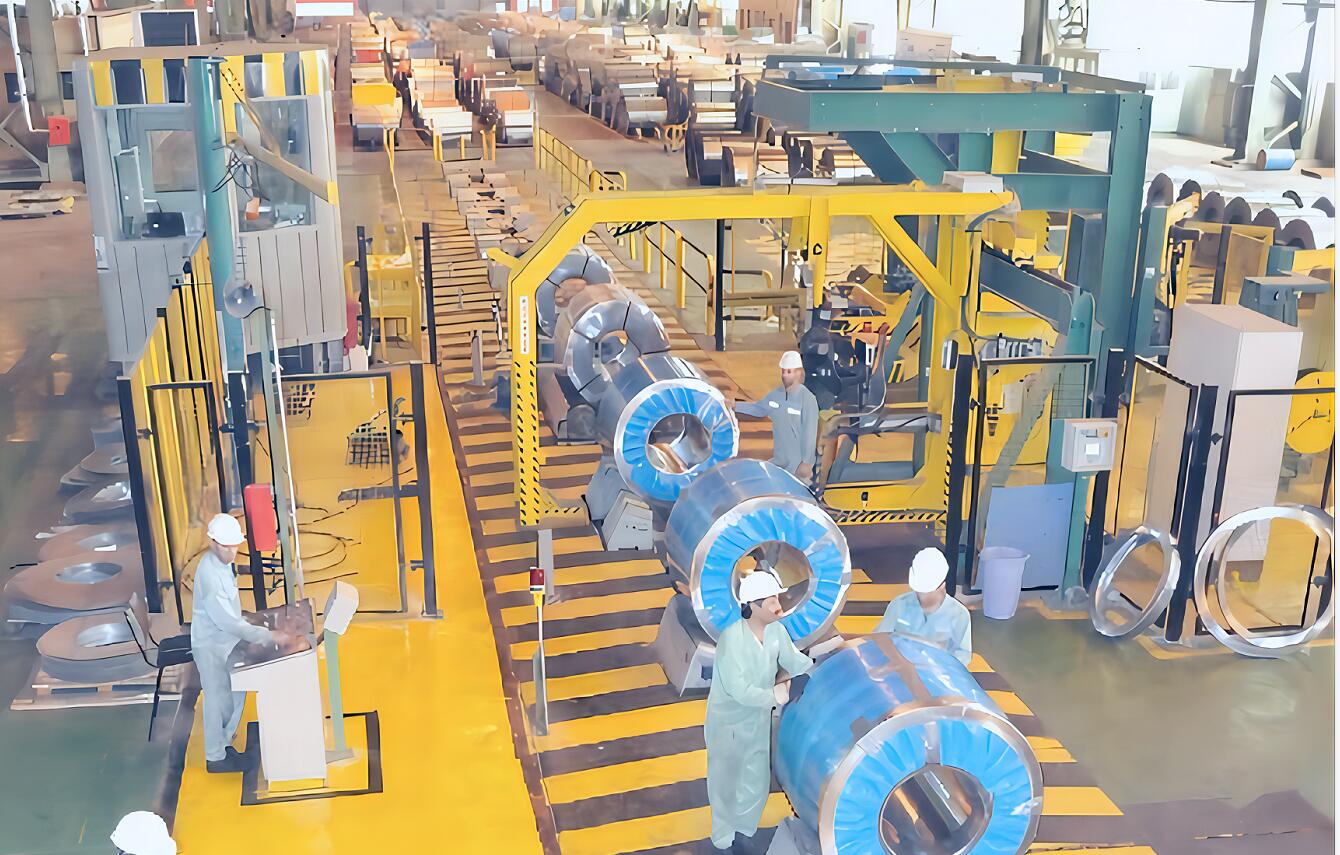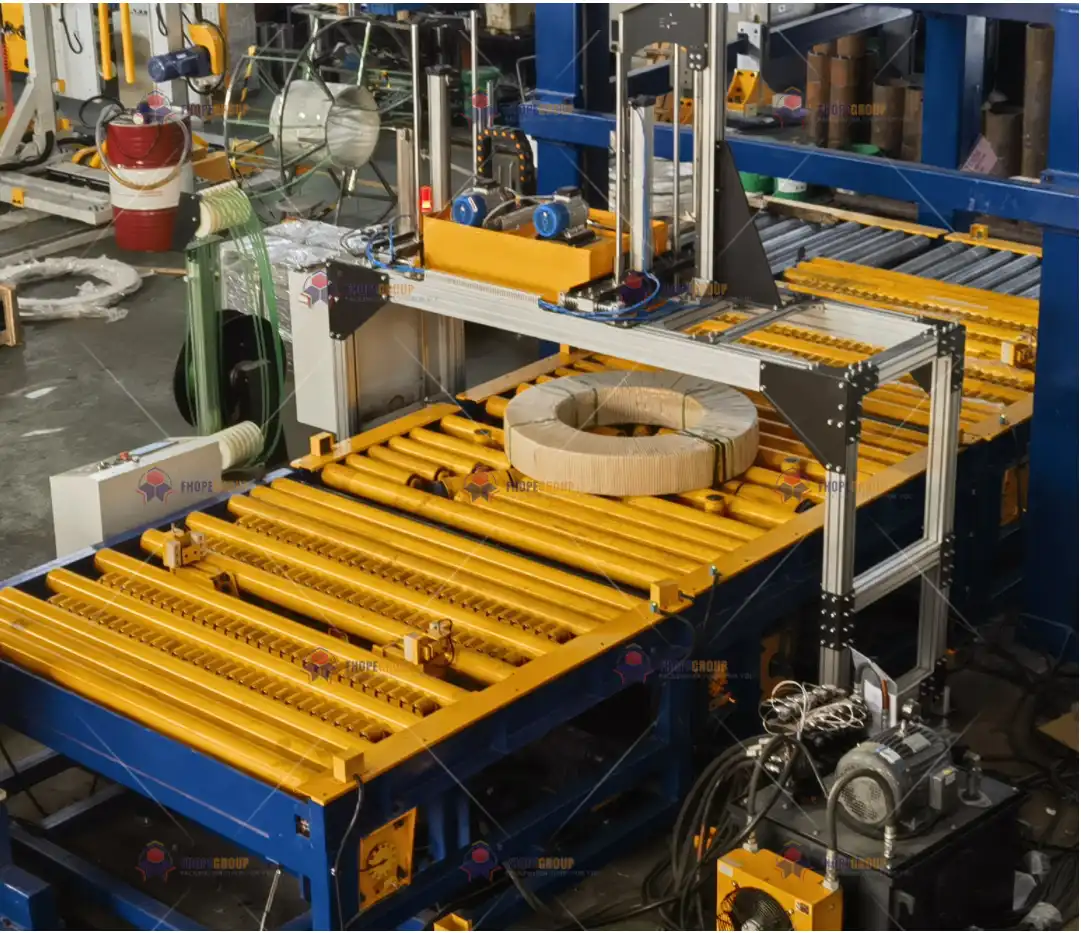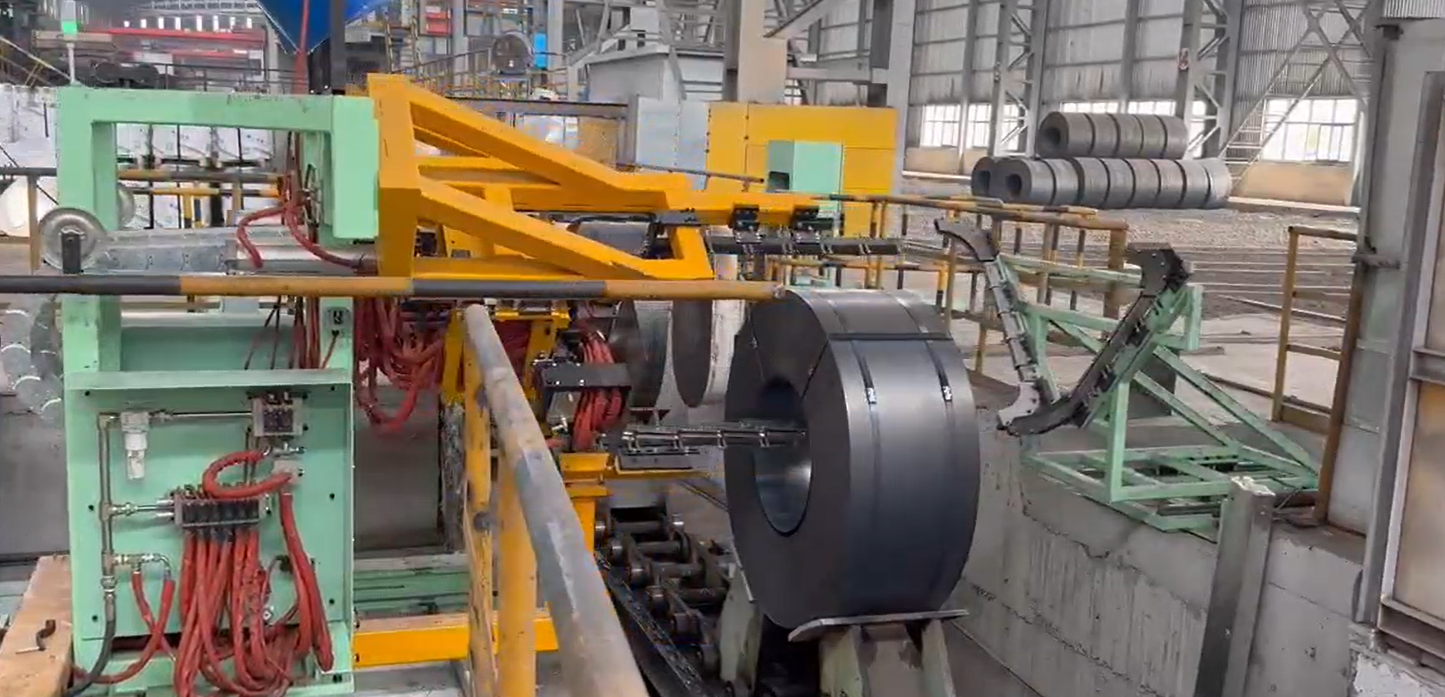Your steel mill in Vietnam is a powerhouse. You have invested in the best furnaces and rolling technology. Your teams work hard to produce high-quality steel coils. Yet, when it comes to shipping, you face frustrating delays. These delays are not just an inconvenience. They can lead to missed shipping deadlines, financial penalties, and unhappy customers. You might be looking everywhere for the bottleneck, but the problem is often hiding in plain sight, at the very end of your production line. The issue is likely your steel coil packing line, an often-overlooked area that can cripple your entire export operation.
Yes, an inefficient or outdated steel coil packing line is a major reason for slow exports from Vietnam. This final stage of production is critical but frequently underestimated. A slow, unreliable, or inadequate packing system directly limits your throughput, compromises product quality during transit, and prevents you from meeting the tight schedules required for international shipping. It becomes the bottleneck that restricts the full potential of your entire mill.

I have spent my entire career in the packing machine industry. I started on the factory floor and eventually built my own company, SHJLPACK. I have seen countless steel mills invest millions in production, only to be held back by an inadequate packing process. You have perfected the art of making steel. Now, let's look at how to perfect the process of getting it to your customers. We will explore the common issues with older packing lines and how a modern solution can transform your export business.
Are outdated packing machines creating a bottleneck for your entire production line?
You see it every day. Your state-of-the-art rolling mill produces coils at an impressive speed. But then, a pile-up begins. Finished coils sit on the floor, waiting to be packed. This isn't just a storage problem. It's a critical bottleneck that forces your entire production to slow down. The rhythm of your factory is disrupted, schedules become chaotic, and your efficient production line is forced to wait for the slowest link in the chain. The solution is to create a seamless flow from production to shipping, and that requires a packing line that can keep up.
Absolutely. An outdated packing machine is a classic production bottleneck. It cannot match the speed of modern mills, it suffers from frequent breakdowns, and it requires significant manual intervention. This speed and reliability mismatch creates a logjam, forcing your high-capacity production equipment to operate at a fraction of its potential just to accommodate the slow pace of the packing station.

The True Cost of a Throughput Mismatch
The problem is more than just a queue of coils. A throughput mismatch has a domino effect that ripples backward through your entire operation. When the packing area is full, you have no choice but to slow down or even stop the rolling mill. This reduces your overall plant efficiency and increases the cost per ton of steel produced. I remember visiting a steel plant in Southeast Asia. They were incredibly proud of their new mill, and rightfully so. But when I walked over to their packing area, it was a scene of organized chaos. Coils were everywhere. The plant manager told me they had to pause production for at least one shift per week just to allow the packing team to catch up. That is a massive loss of potential revenue, all because the final step couldn't keep pace. The true cost is not just in the packing department; it is measured in lost production for the entire factory.
Identifying the Hidden Signs of a Bottleneck
Sometimes, a bottleneck is not as obvious as a pile of coils. You need to look for the subtler signs. Are your skilled operators spending more time troubleshooting the packing machine than running it? Is your maintenance team constantly being called to the packing area for emergency repairs? These are clear indicators that your equipment is struggling. An aging machine is not just slow; it is unpredictable. This unpredictability makes production planning nearly impossible and directly affects your ability to promise and meet delivery dates for your exports from Vietnam. A modern line provides the consistency you need to run a predictable, efficient operation.
Here is a simple comparison of what a typical old line looks like versus a modern one:
| Feature | Outdated Packing Line (15+ years old) | Modern SHJLPACK Line |
|---|---|---|
| Throughput | 5-10 Coils / Hour | 20-30+ Coils / Hour |
| Typical Uptime | 75% - 85% | 95%+ |
| Labor Requirement | 3-4 Operators | 1-2 Operators |
| Changeover Time | 30-45 minutes (manual) | < 10 minutes (automated) |
| Data Integration | None or limited | Full MES/ERP Integration |
As you can see, the difference is not small. It is a fundamental shift in capability that directly impacts your plant's overall output and profitability.
How can a modern packing line reduce your operational costs and energy consumption?
As a steel mill owner, you are in a constant battle with rising costs. Energy prices fluctuate, and labor expenses continue to climb. Every dollar wasted on inefficiency directly eats into your profit margins, which are already tight in this competitive industry. You may not realize it, but your old packing line is likely a significant source of these hidden costs. It probably uses outdated, energy-hungry motors and pneumatic systems with constant air leaks. It also requires a larger team to operate and handle materials. A modern packing line is engineered specifically to combat these issues, using smart technology to cut energy use, reduce labor needs, and boost your bottom line.
A modern packing line directly reduces operational costs and energy consumption in three ways. First, it uses energy-efficient components like servo motors and Variable Frequency Drives (VFDs) that consume far less power. Second, its high level of automation reduces the need for manual labor. Third, it minimizes the waste of expensive packaging materials like stretch film and VCI paper through precise, repeatable application.

Slashing Energy Bills at the Final Stage
Let’s talk about energy, a major challenge for every steel producer. Older packing machines often rely on hydraulic power packs or oversized pneumatic systems that run continuously, even when the machine is idle. This is like leaving a car engine running all day. These systems are also prone to leaks, meaning your air compressors work harder just to maintain pressure, wasting electricity. In contrast, a modern line from SHJLPACK uses electric servo motors and VFDs. These systems only draw significant power when they are actually moving. The difference is dramatic. An old wrapping motor might consume power constantly, while a new servo-driven system uses up to 50% less energy for the same task. When I work with clients, we often perform an energy audit. I once worked with a mill owner in Mexico who was facing huge electricity bills. He was skeptical that a packing machine could make a real difference. We found that his old line's pneumatic system had so many small leaks that it was costing him thousands of dollars a year in wasted compressed air. Upgrading to a modern, all-electric line offered a payback period of less than three years from energy and labor savings alone.
Optimizing Labor and Material Usage
Beyond energy, a modern line attacks costs by optimizing labor and materials. An old, semi-automatic line might require three or four people to place strapping, feed wrapping material, and move the coils. An automated line can perform all these tasks with just one supervisor. In a market like Vietnam where skilled labor is becoming more valuable, this is a huge advantage. It also reduces the risk of human error. Automation also leads to significant savings in packaging materials. A manual operator might apply too much or too little stretch film. An automated wrapper applies the exact amount needed for secure transport, every single time. It can pre-stretch the film, meaning you use less material to get the same or better load containment. This precision can reduce your film consumption by 20-30%, which adds up to a substantial saving over a year. It's a clear path toward the goal of reducing overall operating costs.
Does your current packing solution meet the evolving standards for international shipping?
You have done the hard work. You have produced a high-quality steel coil that meets all the metallurgical specifications. You have secured a valuable export contract to a customer in Europe or North America. But the journey is not over. The coil must now survive weeks on a container ship, facing moisture, salt spray, and rough handling. If your packaging fails, the coil can arrive rusted or damaged. This leads to expensive claims, rejected shipments, and, worst of all, a loss of trust with your customer. International clients have increasingly strict packaging standards, and your old system may not be up to the task.
Your current packing solution likely does not meet the evolving standards for international shipping if it cannot provide a consistent, waterproof, and durable package. International standards now demand superior rust prevention using materials like VCI, secure strapping patterns to prevent shifting during transit, and clear, scannable labeling. Older packing systems often lack the control and flexibility to apply these modern materials and techniques effectively, putting your valuable exports at risk.

Protection From the Elements: More Than Just a Wrapper
For steel coils exported from a humid climate like Vietnam, rust is the number one enemy. A simple layer of plastic is not enough. Modern shipping standards require a multi-layered defense. This often involves using VCI (Vapor Corrosion Inhibitor) paper or film. VCI materials release a harmless vapor that forms a protective, invisible layer on the surface of the steel, preventing moisture from causing rust. An old packing machine may not be able to handle these specialized materials properly. It might tear the paper or fail to create a complete, airtight seal. A modern packing line from SHJLPACK is designed to work with these materials. It can apply a "cocoon" style wrap, where the coil is fully encased, providing maximum protection against the harsh marine environment. When your customer in a different continent cuts open the package, they should see a bright, clean steel coil, just as it looked when it left your mill. This is how you build a reputation for quality.
The Importance of Secure and Standardized Strapping
Damage during handling is another major risk. Coils are heavy and can be dangerous if they are not secured properly. International ports and logistics companies have specific rules for how coils must be strapped for safe lifting and transport. This includes the type of strap (steel or high-strength PET), the number of straps, and their placement (circumferential around the outside, or through the "eye" of the coil). An old strapping machine may not have the precision or power to apply straps with consistent tension. A loose strap is useless, and a strap that is too tight can damage the edges of the coil. Modern strapping heads are fully automated and programmable. You can set the exact tension required and switch between different strapping patterns depending on the customer's needs. This ensures safety, complies with international standards, and protects your product. It shows your customers that you are a professional, reliable partner.
My Insights: What role does automation play in future-proofing your Vietnamese steel export business?
As a business owner, you are always thinking about the future. You worry about rising labor costs, finding skilled workers, and staying ahead of the competition in a tough global market. Relying on old technology and manual processes makes your business vulnerable. A key operator could leave, disrupting your entire workflow. A competitor could adopt new technology and produce faster and cheaper than you. To secure the long-term success of your business in Vietnam, you cannot just think about today's problems. You must invest in solutions that will make you stronger tomorrow. Automation is that solution. It is not just about replacing people; it's about building a more resilient, data-driven, and competitive operation.
Automation's role is to fundamentally future-proof your steel export business. It creates consistency in quality and throughput that is not dependent on a specific person or shift. It reduces costly human errors and, most importantly, it generates the data needed to connect your packing line to your factory's digital ecosystem (MES/ERP). This integration is the key to unlocking true operational efficiency and long-term competitiveness.

From Manual Labor to Smart Systems
When I started my journey in this industry, packing was seen as a low-skill, manual job at the end of the line. Now, it is becoming one of the most data-rich points in the entire factory. This is the power of automation. A modern, automated packing line is a smart system. It can be integrated directly with your Manufacturing Execution System (MES). This means that when a coil arrives for packing, the system already knows its dimensions, weight, and destination. It automatically selects the correct packaging recipe without any human input. This eliminates mistakes and speeds up the process. This level of integration is essential for achieving the kind of digital transformation that forward-thinking leaders are pursuing. It turns your packing area from an isolated island into a fully connected part of your smart factory.
The Data You Didn't Know You Needed
An automated packing line does more than just wrap coils; it generates a wealth of valuable data. It can tell you exactly how many coils you packed per shift. It can track precisely how much wrapping film or VCI paper was used for each coil. It can log every second of downtime and tell you the exact cause. This data is gold. You can use it to track your costs with incredible accuracy. You can identify trends and optimize your use of materials. Most importantly, you can implement predictive maintenance. Sensors on the machine can monitor motor temperature, vibration, and other key indicators. The system can then alert your maintenance team that a component needs attention before it fails. This is how you achieve 95% or higher uptime. It’s about moving from a reactive "fix it when it breaks" model to a proactive, data-driven strategy.
My Vision for the Future of Packing
When I decided to start my own factory, SHJLPACK, my goal was not just to build machines. It was to build solutions that would help my clients succeed. I am grateful for what this industry has given me, and I want to share what I have learned. My vision is that the packing line should not be a cost center, but a strategic asset. The future is an intelligent packing system that helps you run your business better. Imagine a line that can adjust its wrapping technique based on the weather forecast for the shipping route. Imagine a machine that automatically re-orders its own packaging materials when supplies run low. This is not science fiction. This is the direction we are heading. It is about providing you not just with a machine, but with a total solution and a partnership to help you grow.
Conclusion
Upgrading your packing line isn't just another expense. It is a strategic investment in speed, reliability, and your international reputation. It is the key to unlocking your full export potential.





